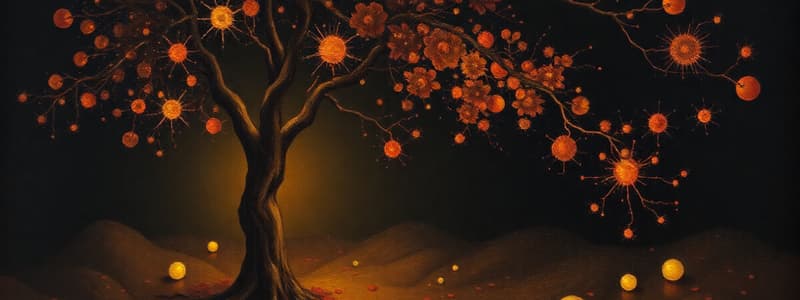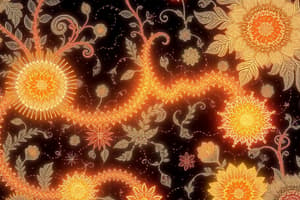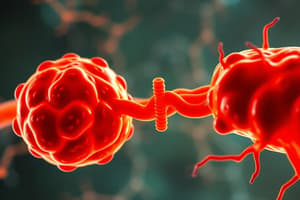Podcast
Questions and Answers
Where does the citric acid cycle primarily take place?
Where does the citric acid cycle primarily take place?
- In the nucleus
- In the mitochondria (correct)
- In the cytoplasm
- In the endoplasmic reticulum
Which of the following is NOT a type of electron carrier found in the electron-transport chain complexes?
Which of the following is NOT a type of electron carrier found in the electron-transport chain complexes?
- Flavin mononucleotide (FMN)
- Iron-sulfur clusters
- Nicotinamide adenine dinucleotide (NAD) (correct)
- Cytochromes
What is the primary function of coenzyme Q (ubiquinone) in the electron transport chain?
What is the primary function of coenzyme Q (ubiquinone) in the electron transport chain?
- To transport protons across the membrane
- To accept electrons and transfer them between complexes (correct)
- To synthesize ATP directly
- To provide hydrogen for the citric acid cycle
Which deficiency is associated with a lack of hydride ion transfer?
Which deficiency is associated with a lack of hydride ion transfer?
What is the impact when ubiquinone accepts two electrons?
What is the impact when ubiquinone accepts two electrons?
What is the main purpose of oxidative phosphorylation in cellular respiration?
What is the main purpose of oxidative phosphorylation in cellular respiration?
What is the significance of the proton gradient in oxidative phosphorylation?
What is the significance of the proton gradient in oxidative phosphorylation?
What role does the inner membrane of mitochondria play?
What role does the inner membrane of mitochondria play?
Which of the following statements about the outer membrane of mitochondria is true?
Which of the following statements about the outer membrane of mitochondria is true?
What did Peter Mitchell contribute to the understanding of oxidative phosphorylation?
What did Peter Mitchell contribute to the understanding of oxidative phosphorylation?
How is energy released by electron transport utilized in oxidative phosphorylation?
How is energy released by electron transport utilized in oxidative phosphorylation?
What would happen if the membranes involved in chemiosmotic energy coupling were not present?
What would happen if the membranes involved in chemiosmotic energy coupling were not present?
Which compartment of the mitochondrion has a higher concentration of protons?
Which compartment of the mitochondrion has a higher concentration of protons?
What is the primary function of Cytochromes in the electron transport chain?
What is the primary function of Cytochromes in the electron transport chain?
Which of the following statements about iron-sulfur proteins is true?
Which of the following statements about iron-sulfur proteins is true?
What role does the chemiosmotic model play in ATP synthesis?
What role does the chemiosmotic model play in ATP synthesis?
Which enzyme complex identified in the mitochondrial respiratory chain has the highest mass?
Which enzyme complex identified in the mitochondrial respiratory chain has the highest mass?
How does the number of subunits in the human cytochrome c compare to that of other complexes?
How does the number of subunits in the human cytochrome c compare to that of other complexes?
What is the primary prosthetic group found in Succinate dehydrogenase?
What is the primary prosthetic group found in Succinate dehydrogenase?
Which components are part of the prosthetic groups in Ubiquinone: cytochrome c oxidoreductase?
Which components are part of the prosthetic groups in Ubiquinone: cytochrome c oxidoreductase?
What distinct feature is observed in the structure of iron-sulfur clusters?
What distinct feature is observed in the structure of iron-sulfur clusters?
What effect does the addition of cyanide (CN-) have on cellular respiration?
What effect does the addition of cyanide (CN-) have on cellular respiration?
How do venturicidin and oligomycin affect ATP synthesis?
How do venturicidin and oligomycin affect ATP synthesis?
What is the primary function of uncouplers like dinitrophenol (DNP)?
What is the primary function of uncouplers like dinitrophenol (DNP)?
What role does valinomycin play in mitochondrial function?
What role does valinomycin play in mitochondrial function?
What physiological role does thermogenin play in brown adipose tissue?
What physiological role does thermogenin play in brown adipose tissue?
What is the result of using the malate-aspartate shuttle in the liver, kidneys, and heart?
What is the result of using the malate-aspartate shuttle in the liver, kidneys, and heart?
How does the glycerol-3-phosphate shuttle differ from the malate-aspartate shuttle?
How does the glycerol-3-phosphate shuttle differ from the malate-aspartate shuttle?
What is a consequence of the proton gradient established across the mitochondrial membrane?
What is a consequence of the proton gradient established across the mitochondrial membrane?
What triggers the activation of caspases during apoptosis?
What triggers the activation of caspases during apoptosis?
What is the inheritance pattern of mitochondrial DNA?
What is the inheritance pattern of mitochondrial DNA?
Which of the following is primarily synthesized in the cytosol and then imported into the mitochondria?
Which of the following is primarily synthesized in the cytosol and then imported into the mitochondria?
What condition is characterized by defects in oxidative phosphorylation leading to low ATP levels?
What condition is characterized by defects in oxidative phosphorylation leading to low ATP levels?
What is the primary measure of the energy status of a cell during oxidative phosphorylation?
What is the primary measure of the energy status of a cell during oxidative phosphorylation?
How is the proton motive force created in mitochondria?
How is the proton motive force created in mitochondria?
Which is one of the key roles of ribosomes found in mitochondria?
Which is one of the key roles of ribosomes found in mitochondria?
Which compound is produced during the conversion of pyruvate to acetyl-CoA?
Which compound is produced during the conversion of pyruvate to acetyl-CoA?
What is the primary function of ATP in the cell?
What is the primary function of ATP in the cell?
What is the total ATP yield when using the Malate Shuttle?
What is the total ATP yield when using the Malate Shuttle?
Which process is directly linked to the failure of mitochondria in insulin release?
Which process is directly linked to the failure of mitochondria in insulin release?
How is the rate of ATP synthesis primarily regulated during oxidative phosphorylation?
How is the rate of ATP synthesis primarily regulated during oxidative phosphorylation?
Which of the following correctly describes the effect of high ATP concentrations on oxidative phosphorylation?
Which of the following correctly describes the effect of high ATP concentrations on oxidative phosphorylation?
What is the role of the Mass-Action Ratio in ATP synthesis?
What is the role of the Mass-Action Ratio in ATP synthesis?
Which intermediate is derived from citrate during the Krebs cycle?
Which intermediate is derived from citrate during the Krebs cycle?
What is the outcome of the reaction catalyzed by FAD in the Krebs cycle?
What is the outcome of the reaction catalyzed by FAD in the Krebs cycle?
Flashcards
Matrix location in cellular respiration
Matrix location in cellular respiration
The matrix is the location within mitochondria where the citric acid cycle and parts of lipid and amino acid metabolism take place.
Electron carriers in ETC
Electron carriers in ETC
Electron-transport chain complexes contain different molecules that carry electrons, including flavin mononucleotide (FMN), flavin adenine dinucleotide (FAD), cytochromes, and iron-sulfur clusters.
Coenzyme Q's role
Coenzyme Q's role
Coenzyme Q, also known as ubiquinone, is a lipid-soluble electron carrier that transports electrons from complexes I and II to complex III.
Electron transfer order
Electron transfer order
Signup and view all the flashcards
Coenzyme function
Coenzyme function
Signup and view all the flashcards
Oxidative Phosphorylation
Oxidative Phosphorylation
Signup and view all the flashcards
Chemiosmotic Theory
Chemiosmotic Theory
Signup and view all the flashcards
ATP Synthesis
ATP Synthesis
Signup and view all the flashcards
Mitochondrial Membranes
Mitochondrial Membranes
Signup and view all the flashcards
Electron Transport Chain Complexes
Electron Transport Chain Complexes
Signup and view all the flashcards
Reduced Cofactors
Reduced Cofactors
Signup and view all the flashcards
Mitochondrial Compartments
Mitochondrial Compartments
Signup and view all the flashcards
Proton Gradient
Proton Gradient
Signup and view all the flashcards
Cytochromes
Cytochromes
Signup and view all the flashcards
Iron-Sulfur Proteins
Iron-Sulfur Proteins
Signup and view all the flashcards
Chemiosmotic Model
Chemiosmotic Model
Signup and view all the flashcards
Proton-motive force
Proton-motive force
Signup and view all the flashcards
NADH dehydrogenase
NADH dehydrogenase
Signup and view all the flashcards
Succinate dehydrogenase
Succinate dehydrogenase
Signup and view all the flashcards
Cytochrome c oxidoreductase
Cytochrome c oxidoreductase
Signup and view all the flashcards
Cytochrome oxidase
Cytochrome oxidase
Signup and view all the flashcards
Cyanide & Respiration
Cyanide & Respiration
Signup and view all the flashcards
Succinate & ATP Synthesis
Succinate & ATP Synthesis
Signup and view all the flashcards
Dinitrophenol: ATP Uncoupler
Dinitrophenol: ATP Uncoupler
Signup and view all the flashcards
Ionophores: Gradient Disruption
Ionophores: Gradient Disruption
Signup and view all the flashcards
Artificial Gradient & ATP Synthesis
Artificial Gradient & ATP Synthesis
Signup and view all the flashcards
Thermogenin: Heat Production
Thermogenin: Heat Production
Signup and view all the flashcards
Malate-Aspartate Shuttle
Malate-Aspartate Shuttle
Signup and view all the flashcards
Glycerol-3-Phosphate Shuttle
Glycerol-3-Phosphate Shuttle
Signup and view all the flashcards
What is the role of ADP in Oxidative Phosphorylation?
What is the role of ADP in Oxidative Phosphorylation?
Signup and view all the flashcards
What is the Mass-Action Ratio?
What is the Mass-Action Ratio?
Signup and view all the flashcards
How does high ATP regulate Oxidative Phosphorylation?
How does high ATP regulate Oxidative Phosphorylation?
Signup and view all the flashcards
What happens when Oxidative Phosphorylation is inhibited?
What happens when Oxidative Phosphorylation is inhibited?
Signup and view all the flashcards
How is Oxidative Phosphorylation regulated?
How is Oxidative Phosphorylation regulated?
Signup and view all the flashcards
What is the relationship between Oxidative Phosphorylation and ATP synthesis?
What is the relationship between Oxidative Phosphorylation and ATP synthesis?
Signup and view all the flashcards
What is the significance of the proton gradient in Oxidative Phosphorylation?
What is the significance of the proton gradient in Oxidative Phosphorylation?
Signup and view all the flashcards
How does the electron transport chain contribute to ATP production?
How does the electron transport chain contribute to ATP production?
Signup and view all the flashcards
Feedback Inhibition in Glycolysis
Feedback Inhibition in Glycolysis
Signup and view all the flashcards
Mitochondria's Role in Apoptosis
Mitochondria's Role in Apoptosis
Signup and view all the flashcards
Mitochondrial DNA inheritance
Mitochondrial DNA inheritance
Signup and view all the flashcards
Mitochondrial Gene Expression
Mitochondrial Gene Expression
Signup and view all the flashcards
Mitochondrial Diabetes
Mitochondrial Diabetes
Signup and view all the flashcards
Chemiosmotic Theory & Mitochondria
Chemiosmotic Theory & Mitochondria
Signup and view all the flashcards
Electron Carriers in Oxidative Phosphorylation
Electron Carriers in Oxidative Phosphorylation
Signup and view all the flashcards
ATP Production and Uncoupling
ATP Production and Uncoupling
Signup and view all the flashcards
Study Notes
Oxidative Phosphorylation Overview
- Oxidative phosphorylation harnesses energy from NADH and FADH₂ to produce ATP.
- Carbohydrates, lipids, and amino acids are the primary reduced fuels for the cell.
- Electrons from reduced fuels are transferred to NADH or FADH₂ cofactors.
Chemiosmotic Theory
- Energy needed to phosphorylate ADP comes from protons flowing down an electrochemical gradient.
- ΔG is directly related to ΔE = Eo (e⁻ acceptor) – Eo (e⁻ donor).
- ΔG = - ηIΔE, where T = 298°K = 25°C, R = 8.315 J/mol·K, η = # electrons transferred per molecule, J = 96.48 kJ/V·mol (Faraday).
Chemiosmotic Energy Coupling
- Proton gradient needed for ATP synthesis is established across membranes impermeable to ions.
- These include the plasma membrane in bacteria, inner membrane in mitochondria, and thylakoid membrane in chloroplasts.
- Membranes must contain proteins to couple electron flow (downhill) with proton flow (uphill) across the membrane.
- A protein couples the downhill flow of protons to the phosphorylation of ADP.
Structure of Mitochondrion
- Double membrane creates four distinct compartments:
- Outer membrane: relatively porous, permeable to small molecules.
- Intermembrane space (IMS): Similar environment to cytosol, with higher proton concentration (lower pH).
- Inner membrane: Impermeable, with proton gradient across it. Contains complexes of electron transport chain and cristae to increase surface area.
- Matrix: Contains citric acid cycle enzymes, fatty acid oxidation enzymes, amino acid oxidation enzymes, DNA, ribosomes, etc. Lower proton concentration (higher pH).
Electron Transport Chain Complexes
- Each complex contains multiple redox centers, including flavin mononucleotide (FMN) or flavin adenine dinucleotide (FAD), cytochromes (a, b, or c), and iron-sulfur clusters.
- Electron transfer order depends on reduction potential.
Coenzymes as Electron Carriers
- Coenzymes associated with dehydrogenases transfer hydride ions (H⁻, one proton plus two electrons).
- NAD+/NADH, FMN/FMNH₂, FAD/FADH₂ are important coenzymes.
Coenzyme Q (Ubiquinone)
- Lipid-soluble quinone isoprenoid compound, readily accepting electrons from different redox-active compounds.
- Accepts two electrons, picks up two protons to become ubiquinol.
- Freely diffuses, carrying electrons with protons across the membrane.
- Mobile electron carrier, transporting electrons from Complexes I and II to Complex III.
Cytochromes
- Composed of Fe³⁺/Fe²⁺ redox system and heme derivatives (a, b, or c). Ring additions/substitutions affect redox properties.
- One-electron carriers.
Iron-Sulfur Proteins
- One-electron carriers based on Fe³⁺/Fe²⁺ redox system.
- Iron ions coordinated by cysteine in proteins or as iron-sulfur clusters.
- Iron-sulfur clusters have equal numbers of iron and sulfur atoms.
Chemiosmotic Model for ATP Synthesis
- Electron transport through complexes I-IV creates a proton-motive force (proton gradient).
- Energy of proton-motive force drives ATP synthesis.
Mitochondrial ATP Synthase Complex
- Composed of two functional units, Fo and F₁.
- Fo is the integral membrane complex that transports protons dissipating the proton gradient.
- F₁ is the soluble complex in matrix catalyzing ATP hydrolysis and creation.
- Dimers exist in different conformations (open, loose, tight).
Synthesis of ATP in ATP Synthase
- Translocation of three protons fuels synthesis of one ATP.
Inhibitors
- Cyanide (CN⁻), carbon monoxide, antimycin A, myxothiazol, rotenone, amytal, piericidin A, DCMU, oligomycin, venturicidin, DCCD, FCCP, DNP, valinomycin, and atractyloside interfere with the process.
Transport of Different Species in/Out of Matrix
- Proton translocation facilitates cotransport of substrates into and products out of the mitochondria.
Malate-Aspartate Shuttle
- This shuttle transports reducing equivalents (NADH) from cytosol into the mitochondrial matrix.
Glycerol-3-Phosphate Shuttle
- An alternative mechanism for shuttling reducing equivalents (NADH) from cytosol to the mitochondrial matrix. This process results in the formation of FADH₂, rather than NADH, resulting in a lower energy yield (1 ATP less per NADH)
Regulation of Oxidative Phosphorylation
- Primarily regulated by substrate availability (NADH and ADP/Pi).
- Rate of O₂ consumption regulated by the amount of ADP/Pi.
- High ATP levels cause feedback inhibition Cascade up to PFK-1.
Mitochondria and Apoptosis
- Loss of mitochondrial membrane integrity releases cytochrome c, initiating apoptosis (programmed cell death).
Mitochondrial Genetics
- Mitochondrial DNA is circular and encodes rRNA, tRNA, and enzymes of central metabolism.
- Mitochondria have their own ribosomes for protein synthesis.
- Mitochondrial DNA is maternally inherited.
Mitochondrial Mutations and Diabetes
- Defects in oxidative phosphorylation result in low ATP, inhibiting correct insulin release from pancreatic β cells.
Studying That Suits You
Use AI to generate personalized quizzes and flashcards to suit your learning preferences.




